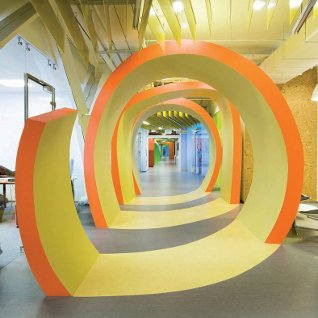Yandex offices, St Petersburg
Large-scale sculptures based on computer symbols were installed to make the interiors scheme for a Russian media company into a ‘unique, stunning workplace’. Job done.
Client: Yandex
Design: Za Bor Architects
Size: 3,280 sq m
Completion time: 12 months
For architects and designers, building close and trusting relationship with a client can have the obvious benefit of repeat business. But as Russian practice Za Bor Architects found, the trust that is built over a long-term working relationship can be a spur for creativity too.
Za Bor Architects recently completed its 16th office project for Russian media company Yandex, and after so many successful projects the client was willing to let the practice push the boat out with the design. Specifications aside, Yandex asked for 'an unusually spectacular, stunning workplace like no other', and the rest was a matter for the architects. 'Yandex's participation didn't include matters of creativity,' says architect Arseniy Borisenko. 'When we work with Yandex we usually propose a solution and it is either accepted or we prepare a new one; with this project, everything was accepted at first glance.'
Where Yandex did get involved was in the logistics of the project. 'Yandex has its own department for office equipment and ordered the furniture and materials we chose, and helped to solve other administrative issues,' says fellow architect Peter Zaytsev.
The company occupies the entire fourth floor of the building with a 200m-long corridor running through the centre with meeting rooms and offices branching off from the central corridor. An awkward layout that the designers say was one of the most challenging features of the project. Another challenge, says Zaytsev, was to 'make the office showy and impressive' which they did by creating large sculptures inspired by computer graphics. There are walls that look like they are made of pixels, a giant amorphous clock (nicknamed the jellyfish clock) and several icons instantly recognisable from the computer desktop - including the pointing hand 'click here' icon and the '@' symbol.
But Borisenko says these brightly coloured, larger-than-life icons, made of polymer and polystyrene foam, aren't just for show. 'We had to think of a "very unusual office", but at the same time its parts had to be functional. Many of the major elements seem to be purely decorative, but actually have hidden functions. The spiral-shaped icons, for example, separate the informal meeting zone from the corridor, while the clocks contain printer stations.'
Just as the 3D design elements have other uses, so materials and furniture were chosen for more than just the way they look. Zaytsev says all materials used in the project had to meet three criteria: 'They had to be eco-friendly and meet fire regulations, they had to be robust and wear-resistant, and they had to be beautiful.'
Furniture from Herman Miller, Fritz Hansen and Walter Knoll was chosen to enhance the rest of the scheme without detracting from the other design elements. 'We chose a finishing material with a variety of colours, but very simple in texture,' says Zaytsev. We were looking for interesting forms but not flashy colours, because we didn't want the furniture to upstage the 3D objects in the interior, as they are the main visual elements of the project.'
While the giant clocks and pixel walls were relatively simple to make, Zaytsev says the ceiling, which is made of parallel metal 'blades' painted yellow, was tricky. 'Because the blades had to be located strictly parallel to each other, this required us to make many marks on ceiling without making any mistakes,' he says.
Borisenko and Zaytsev say the project ran smoothly thanks to the close relationship between client and designer: 'We've designed and constructed many offices for this company, so the project progressed really quickly. We were already aware of almost all potential pitfalls and so we were able to avoid them.'
While this kind of 'fun' office design is not for everyone, Zaytsev says he hopes this scheme will encourage more companies to get creative with their workplaces. 'Perhaps other companies will also want to enliven their offices, and show their clients that they have the resources and courage to work on their style even in terms of an interior,' he says. 'It would also show that they care about their employees and the working environment.'
Once the preserve of media companies, Borisenko says this type of workplace is becoming more prevalent in other industries, and Za Bor has had enquiries from oil companies to 'enliven' and 'functionalise' their offices. 'Perhaps employers are starting to understand the importance of providing more than a simple workplace for their staff - they have to make them want to go to work.'
Main suppliers
Furniture:
Herman Miller hermanmiller.com
Fritz Hansen fritzhansen.com
Walter Knoll walterknoll.de
Lighting:
XAL xal.com
LUG lug.com
Wall coverings:
Knauf knauf.co.uk
Flooring:
Interface interfaceglobal.com
This article was first published in fx Magazine.












